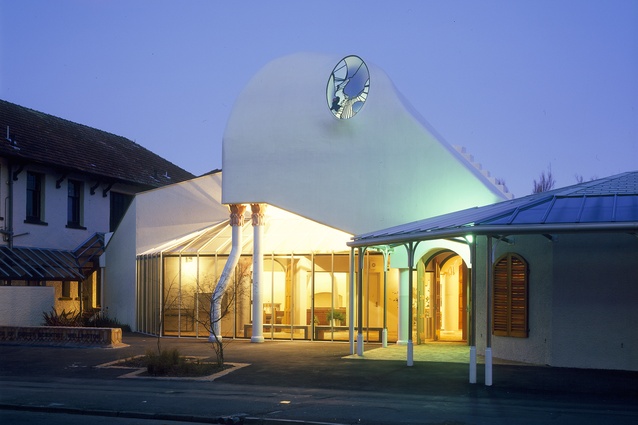Last rites for Athfield-designed church
Demolition is likely to begin on the Ian Athfield-designed First Church of Christ Scientist (1983) on Wellington’s Willis Street next week if the Wellington City Council approves the ‘Consent to Demolish’ application lodged in early June.
The new owner of the 1275m2 central city site, CS No.2 Ltd, plans to replace the 1984 NZIA National Award-winning building with a temporary sales office and work has already begun to remove various artworks from within the church.
The application lodged with Council said: “In the Applicant’s opinion… the proposal to demolish the existing building on the site and establish a sales office is consistent with the purpose of the Resource Management Act, in that it will enable the Applicant to begin the redevelopment of the site for a future residential apartment building.”
Athfield Architects principal Jon Rennie says the practice had been keen to discuss with the developer whether or not there were alternatives that didn’t involve demolition of the significant architectural icon but would still provide the housing Wellington needs.
“With wider intensification, the loss of this community space is highly questionable and, with no visibility of the proposed apartment building, the merits of the application or the implied requirement to demolish can’t be determined,” says Rennie.
“We had hoped to meet with the developer and Wellington City Council to explore options for saving the building through adaptive reuse and/or another encompassing design approach but demolition is likely to proceed, with the removal of artworks currently underway.”
The architects say the unconventional building was designed to question not only the congregation but also passers-by, through both form and ornament. “The shape of the organ loft with its ovoid James Walker stained-glass window invites comparison with animate forms – whale, turtle, insect,” says Rennie. “The bent columns, capped with petal-pink ceramic capitals by Neville Porteous, combine humour and beauty.”
The church’s white stucco on wire mesh frame, aluminium frames, glazed verandah and ceramic tile floors link directly with the verandahs of the two stuccoed, double-height domestic buildings adjoining. Inside, the twisted double columns feature again, as a frame to the reading lectern. The built form surrounds a courtyard with a water feature by Doreen Blumhardt.
In 1993, an addition to the existing church was commissioned to accommodate a reading room and study area, linked back to the original building. The building was required to enhance the urban environment, complement the existing church building and the spaces between, and provide the street with a ‘window’ to the church while providing ‘shelter’ for the reading and study facility and bookshop within.
The 1984 NZIA National award citation describes the church as: “An audacious and unique building, the church not only satisfies its internal functions but also encourages public response. Inside the sense of identity, subtle colour, the inner courtyard and the unifying symbolic features convey peace and tranquillity. The exciting and innovative exterior enriches Willis Street. Modern techniques and beautiful handcrafts are well integrated and pleasing… in this extraordinary, one-off creation.”
Associate Professor at University of Auckland’s School of Architecture and Planning Julia Gatley says this situation echoes that of Āniwaniwa, the John Scott-designed Urewera National Park visitor centre that was demolished in 2016. “The building is such a wonder; its demolition would be a huge loss for Wellington and for New Zealand architecture. It would take a lot of public noise to stop the demolition, given that the building is not scheduled as a heritage item on the district plan.”










